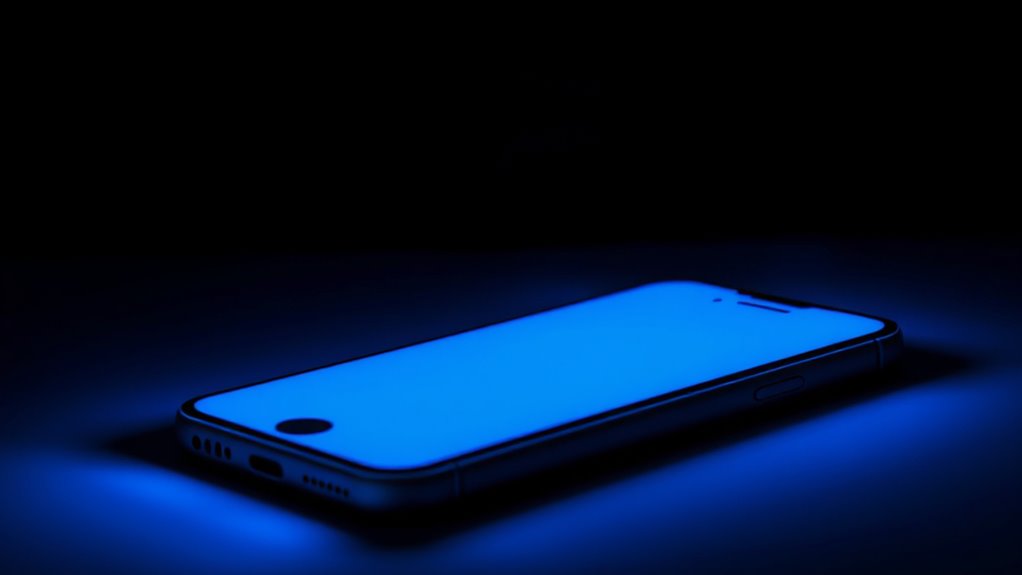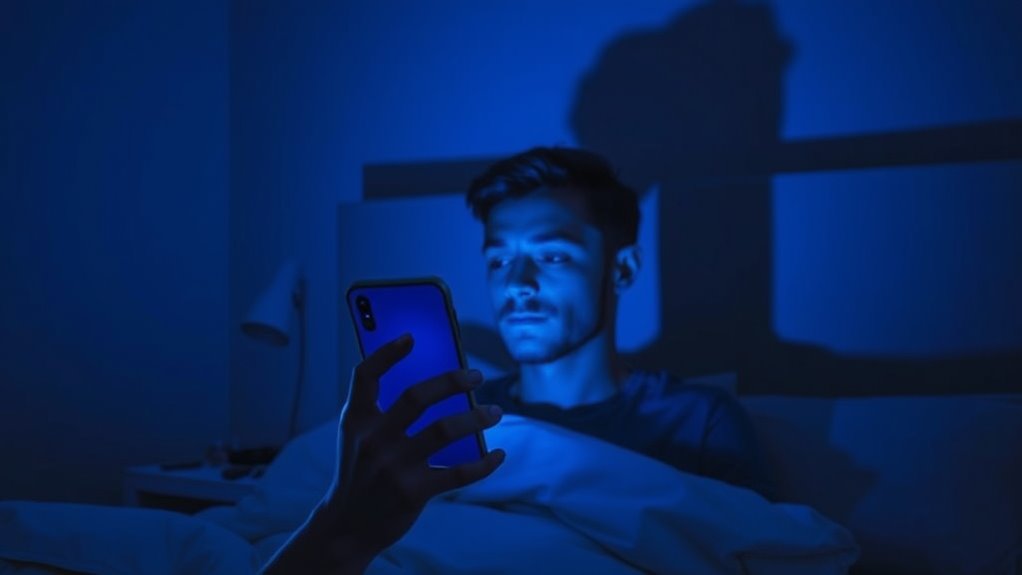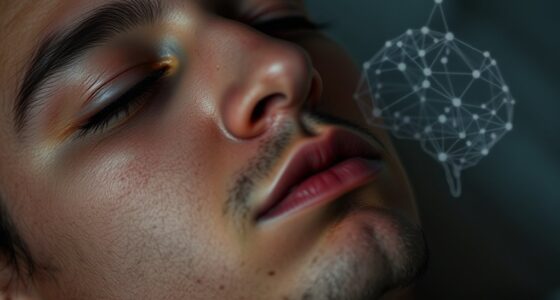Blue light from screens and artificial lighting can disrupt your circadian rhythm by suppressing melatonin, the hormone that signals sleep. When exposed in the evening, blue light delays melatonin release, making it harder to fall asleep and reducing sleep quality. This disruption can affect your overall health and alertness. If you want to learn how to protect your sleep and keep your circadian rhythm in sync, keep exploring these helpful tips.
Key Takeaways
- Blue light exposure, especially in the evening, suppresses melatonin production, disrupting the sleep-wake cycle governed by the circadian rhythm.
- The circadian rhythm, regulated by the SCN in the hypothalamus, aligns body functions with natural light-dark patterns influenced by blue light.
- Excess blue light from screens delays sleep onset and alters sleep stages, leading to fragmented sleep and circadian misalignment.
- Managing blue light exposure through filters, limiting screen time before bed, and maintaining consistent sleep schedules supports healthy circadian rhythms.
- Disruption of circadian rhythms by blue light can cause sleep problems and metabolic issues, emphasizing the importance of light management for overall health.
Understanding Blue Light and Its Sources

Blue light is a high-energy, short-wavelength light that is naturally present in sunlight and emitted by many artificial sources. You’re exposed to it daily through outdoor sunlight, which provides essential illumination. Indoors, screens from smartphones, tablets, computers, and LED or fluorescent lighting emit blue light as well. These sources produce more blue light than traditional incandescent bulbs, making it a significant part of your environment. Because blue light penetrates deep into your eyes, it influences your alertness and sleep patterns. While natural blue light helps regulate your body’s internal clock during the day, prolonged exposure to artificial blue light, especially in the evening, can disrupt your circadian rhythm. Understanding these sources helps you manage your exposure and protect your sleep quality. Additionally, ongoing research highlights the importance of AI Safety measures in developing effective solutions to mitigate blue light’s impact on health.
The Role of Circadian Rhythms in Our Bodies

Your body relies on a biological clock that controls your daily rhythms. Light exposure influences this clock, affecting your sleep patterns and alertness. Hormonal processes also shift throughout the day, helping regulate your overall health and energy levels. Understanding circadian rhythm is essential for maintaining optimal well-being.
Biological Clock Mechanism
The biological clock, also known as the circadian rhythm, governs many of your body’s daily functions by regulating sleep-wake cycles, hormone release, and body temperature. It operates through a network of neurons in your brain’s hypothalamus, called the suprachiasmatic nucleus (SCN). The SCN acts as your master clock, syncing your internal processes with the 24-hour day. It receives light signals from your eyes, which help it adjust to environmental changes. Inside your cells, clock genes create feedback loops that turn genes on and off, controlling biological functions. This intricate system guarantees your body stays aligned with day and night, optimizing your alertness, energy levels, and overall health. Disruptions to this mechanism can lead to sleep issues and metabolic problems. Additionally, light exposure, especially blue light, has a significant impact on circadian regulation by influencing melatonin production.
Light’s Impact on Sleep
Light exposure plays a pivotal role in regulating your sleep patterns by influencing your circadian rhythms. When you’re exposed to natural daylight during the day, it signals your body to stay alert and awake. Conversely, as evening approaches, reduced light prompts your internal clock to prepare for sleep. Blue light, in particular, can delay this process by suppressing melatonin production, making it harder to fall asleep. If you’re exposed to screens late at night, your circadian rhythm gets disrupted, leading to difficulty sleeping and poorer sleep quality. Maintaining a consistent light-dark cycle helps your body sync with natural cues, promoting healthier sleep patterns. Being mindful of your light exposure, especially in the evening, can considerably improve your ability to fall asleep and stay asleep through the night. Understanding circadian rhythms can help you make better choices about your light exposure for optimal sleep health.
Hormonal Regulation Processes
Circadian rhythms serve as the body’s internal timekeepers, orchestrating the release of hormones that regulate various physiological processes throughout the day. When your internal clock aligns with natural light, it signals your body to produce hormones like cortisol and melatonin at ideal times. Cortisol peaks in the morning, helping you wake up and stay alert, while melatonin rises in the evening, promoting sleep. Disrupting this rhythm, such as exposure to blue light at night, can interfere with hormone production, leading to sleep issues and other health problems. Your body relies on this precise hormonal regulation to maintain energy, metabolism, and overall well-being. Understanding these processes highlights how essential maintaining a consistent circadian rhythm is for your health. Proper synchronization of these hormones also supports metabolic health, emphasizing the importance of managing light exposure to maintain hormonal balance.
How Blue Light Disrupts Sleep Patterns

Blue light exposure before bed can suppress your body’s production of melatonin, making it harder to fall asleep. Spending too much time on screens during the evening further disrupts your sleep cycle. As a result, your overall sleep quality and duration may suffer, leaving you feeling tired the next day. Incorporating timing aids can help improve your sleep habits and reduce the impact of blue light.
Melatonin Suppression Effect
When exposed to blue light in the evening, your body’s production of melatonin—the hormone that signals it’s time to sleep—gets considerably suppressed. This suppression occurs because blue light activates specialized receptors in your eyes called intrinsically photosensitive retinal ganglion cells (ipRGCs). These cells send signals to your brain’s suprachiasmatic nucleus (SCN), which controls your circadian rhythm, telling it to delay melatonin release. As a result, your sleep becomes harder to fall asleep and less restorative. The more blue light you’re exposed to before bedtime, the more your melatonin levels drop. This disruption not only delays your sleep onset but can also reduce sleep quality, leaving you feeling tired and less alert the next day. Additionally, research shows that light pollution from screens can lead to long-term circadian rhythm disruptions, affecting overall health.
Screen Time Impact
Spending extended periods looking at screens before bed can considerably disrupt your sleep patterns. Blue light emitted from devices like smartphones, tablets, and computers interferes with your circadian rhythm, making it harder to fall asleep. This disruption reduces sleep quality and can leave you feeling tired the next day. To visualize its impact, consider the following:
| Device Type | Blue Light Exposure |
|---|---|
| Smartphone | High |
| Laptop | Moderate |
| Tablet | High |
| TV | Moderate |
| E-Reader | High |
Limiting screen time before bed, or using blue light filters and glasses, can help you preserve your sleep quality and maintain a healthier circadian rhythm. Regular use of measures like blue light filters may also contribute to lessening the impact of blue light on your sleep cycle.
Sleep Cycle Disruption
Exposure to blue light before sleep doesn’t just delay your bedtime; it actively disrupts your sleep cycle by interfering with the body’s natural production of melatonin. When blue light hits your eyes, it signals your brain that it’s daytime, suppressing melatonin release. This suppression makes it harder to fall asleep and reduces sleep quality once you do. Over time, this disruption can lead to fragmented sleep and difficulty waking up refreshed. To protect your sleep cycle, consider limiting blue light exposure before bed.
- Blue light delays melatonin production
- It shortens REM sleep stages
- You wake feeling less rested
- It increases sleep-onset latency
- Your overall sleep quality declines
Impact of Blue Light on Melatonin Production

Blue light from screens and artificial lighting considerably suppresses melatonin production, the hormone responsible for regulating your sleep-wake cycle. When you’re exposed to blue light in the evening, your body receives signals that it’s daytime, delaying the release of melatonin. This reduction makes it harder for you to fall asleep and decreases sleep quality. Melatonin plays an essential role in signaling your body that it’s time to rest, so inhibiting its production disrupts your circadian rhythm. The more blue light you’re exposed to before bedtime, the greater the suppression. This interference can lead to longer sleep onset, fragmented sleep, and reduced REM sleep, leaving you feeling less rested. Recognizing blue light’s impact on melatonin can help you understand why managing exposure is important for healthy sleep. Additionally, understanding the influence of blue light emphasizes the importance of circadian rhythm for overall well-being and health.
Strategies to Minimize Blue Light Exposure

To protect your sleep from the disruptive effects of blue light, adopting practical strategies can make a noteworthy difference. You can reduce exposure by adjusting your environment and habits. Consider using blue light filters on devices or switching to night mode in the evening. Limit screen time at least an hour before bed to help your body prepare for sleep naturally. Wearing blue light blocking glasses in the evening can also be effective. Additionally, setting boundaries with technology—like turning off notifications—reduces unnecessary exposure. Creating a tech-free zone in your bedroom fosters better sleep hygiene. Ultimately, opt for dim, warm lighting in the evening to signal to your brain that it’s time to wind down. Incorporating crochet styles for locs as a relaxing nighttime activity can further ease your mind before sleep. These simple steps can considerably minimize your blue light exposure and support healthier sleep cycles.
Tips for Maintaining Healthy Sleep-Wake Cycles

Maintaining healthy sleep-wake cycles requires consistent habits and routines that support your body’s natural rhythms. To do this, set a regular sleep schedule, going to bed and waking up at the same times each day, even on weekends. Limit your exposure to bright screens at least an hour before bed, and consider using blue light filters or glasses in the evening. Keep your bedroom dark, cool, and quiet to promote better sleep. Establish relaxing pre-sleep routines like reading or gentle stretching to signal your body it’s time to wind down. Avoid caffeine and heavy meals close to bedtime, as they can disrupt your rest. Staying active during the day also helps regulate your sleep cycle, making it easier to fall asleep and wake up refreshed.
Frequently Asked Questions
Can Blue Light Exposure Affect Mental Health Besides Sleep?
You might wonder if blue light exposure impacts mental health beyond sleep issues. It can, actually. Excessive blue light, especially from screens, may increase feelings of anxiety or depression over time. It can also strain your eyes and cause headaches, adding to stress. By limiting blue light exposure, especially before bed, you might improve not just your sleep but also your overall mood and mental well-being.
Are Children More Vulnerable to Blue Light’s Effects Than Adults?
Children’s delicate development makes them more vulnerable to blue light’s effects than adults. Their still-forming eyes allow more blue light to penetrate, increasing risks like eye strain and potential damage. Plus, their brains are more impressionable, so exposure can influence behavior and mental health. You should be cautious about screen time, especially before bed, to protect their developing eyes and minds from these potential dangers.
Do All Types of Blue Light Have the Same Impact?
When you ask if all types of blue light have the same impact, you’re considering their effects on your eyes and overall health. Not all blue light is equal; some sources, like screens and LED lights, emit higher intensities. You should be aware that certain wavelengths are more harmful, especially at close range or during prolonged exposure. Protect your eyes by limiting exposure, especially before bedtime, and consider using blue light filters.
How Does Blue Light Exposure Vary During Different Seasons?
You notice that blue light exposure changes with seasons. During summer, you get more sunlight, which increases blue light exposure outdoors. In winter, days are shorter, and you spend more time indoors under artificial lighting, often with less blue light. This seasonal variation affects your daily exposure, influencing your sleep and alertness patterns. Being aware of these changes helps you manage your light exposure for better health year-round.
Are There Long-Term Health Consequences of Chronic Blue Light Exposure?
Chronic exposure to blue light can lead to long-term health issues. You might experience disrupted sleep patterns, which affect your overall health and mood. Over time, this can increase your risk for conditions like eye strain, headaches, or even more serious problems such as retinal damage. To protect yourself, limit screen time before bed, use blue light filters, and take regular breaks, especially during extended screen use.
Conclusion
As evening shadows stretch and blue light floods your screens, imagine your body’s internal clock gently whispering for rest. By understanding its dance with blue light, you can protect your sleep and let melatonin flow freely like a calming tide. Dim your screens, embrace the dark, and craft a peaceful nightly routine. In doing so, you’ll restore harmony within, allowing your circadian rhythm to flourish like a serene night sky, guiding you to restful, rejuvenating sleep.









